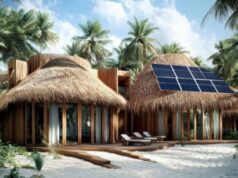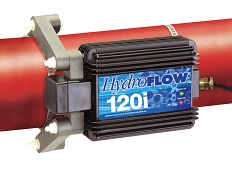 NATIONAL REPORT—Electronic devices have changed the way that people work and live, often simplifying complex tasks. The iPhone is said to have combined more than 15 separate devices that Radio Shack offered, and reduced the cost of ownership while decreasing complexity. The water market offers a large set of opportunities to improve conservation using new technologies. Consider the role that chemicals historically have played for controlling water quality and the millions of gallons of hazardous chemicals that are used each day. Electronic devices are able to reduce water and chemical use by over 50 percent.
NATIONAL REPORT—Electronic devices have changed the way that people work and live, often simplifying complex tasks. The iPhone is said to have combined more than 15 separate devices that Radio Shack offered, and reduced the cost of ownership while decreasing complexity. The water market offers a large set of opportunities to improve conservation using new technologies. Consider the role that chemicals historically have played for controlling water quality and the millions of gallons of hazardous chemicals that are used each day. Electronic devices are able to reduce water and chemical use by over 50 percent.
Cooling towers in the United States use trillions of gallons of water per year to keep building temperatures comfortable. They require three or more separate chemicals to maintain efficient operations by controlling mineral scaling, biological activity, and corrosion. Traditional control measures require chemicals specific to each problem, many of which are hazardous. Chemically treated water cannot easily be reused, so it is discarded into a sanitary sewer after brief use.
Innovations of electronic devices have reduced requirements for chemical additives for achieving water quality objectives, while reducing costs, reducing chemical use significantly, and allowing billions of gallons of water to be repurposed for irrigation or other applications, which conserves drinking water resources.
Saving more than half of a cooling tower’s water use with non-chemical devices is a significant breakthrough for cost savings as well as conservation, and offers these benefits:
• Conserve makeup water volume;
• Reduce chemical additives and costs;
• Avoid sanitary sewer disposal and associated costs; and
• Provide water for irrigation of landscape while avoiding historic water expense.
Saving water twice has significant benefits for conservation of water as well as cost savings.
Some Water Use Details
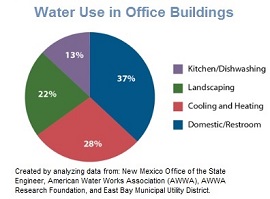 Communities have begun to recognize the importance of conserving water used by residences, businesses and government. The U.S. Geological Survey (USGS) estimated in 2010 that 355 billion gallons of water was used each day in the United States.
Communities have begun to recognize the importance of conserving water used by residences, businesses and government. The U.S. Geological Survey (USGS) estimated in 2010 that 355 billion gallons of water was used each day in the United States.
Office buildings have a large water use “footprint” that accounts for approximately nine percent of the total use of water in the United States, which equals about 31 billion gallons per day.
Approximately half of this total is dedicated to cooling and heating (28 percent) and landscaping (22 percent) of buildings, or approximately 16 billion gallons of water.
Sixteen billion gallons of daily water use presents a big opportunity to develop conservation strategies. An obvious objective that is not frequently practiced is to repurpose discharged cooling tower water to be used for irrigation.
Making better use of this water use is the purpose of this article.
Water Costs Today
The cost of water and wastewater varies by region and city. Houston charges a commercial building $4.10 per 1,000 gallons for fresh water and $6.35 per 1,000 gallons for discharge into a sanitary sewer. An average 1,000 ton cooling tower uses 15 million gallons of water per year, with water costs of nearly $100,000 on average.
Costs for water have increased steadily and will continue to climb as cities use pricing to encourage conservation. The challenge we face is to use water longer without compromising operating efficiencies.
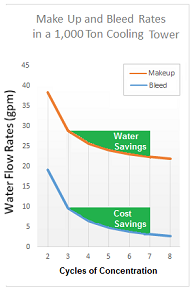 Cycles of Concentration are Key to Water Conservation
Cycles of Concentration are Key to Water Conservation
Cycles of concentration (COC) is the measure of the number of times (or cycles) that dissolved solids in a water system concentrate due to evaporation. In cooling towers or other heat transfer systems, evaporative condensers and fluid coolers remove heat from water by evaporating a small percentage (~1 percent) of the recirculating water. The evaporated water is pure water that leaves dissolved solids such as calcium behind, resulting in an increase in concentration levels.
If the concentration cycle is allowed to continue, the dissolved solids become saturated and begin to form as scale, particularly in areas where heat and pressure undergo change, like chiller units and fill screens.
To prevent this, anti-scaling chemicals are added, and the conductivity of the water is measured to determine the total dissolved mineral content of the water. (Higher conductivity levels indicate higher dissolved minerals in solution).
A cooling system can operate at higher cycles of concentration when scale inhibitors are added, though most automated chemical systems will purge a significant volume of water when three cycles of concentration are achieved.
Increasing COC to six or more would reduce water use by half, but chemical programs are not able to control scaling at these concentrations.
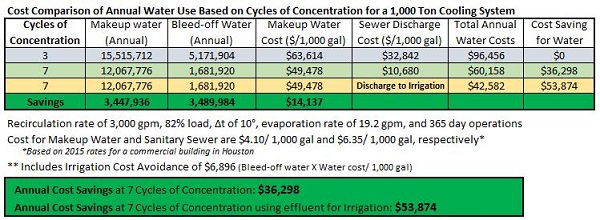
The purged water is usually discharged into a sanitary sewer since the chemicals (anti-scaling, biocides, anti-corrosion, others) prevent reuse of the water. The loss of water is expensive due to cost of new water, as well as the expense of sanitary discharge, and the lost chemistry that needs to be replenished.
Electronic water conditioning has changed this process.
Electronic Water Conditioning Increases Cycles of Concentration
Purging water at three cycles of concentration is prudent in systems that cannot prevent the formation of scale above this level. Chemicals can only go so far, but this limitation is with chemistry, and new approaches are available.
Let’s think differently and consider what happens when a new process causes scale to form in the water as crystals that cannot attach to piping and equipment. With electronic water conditioning, the water can be increased to seven cycles of concentration without concern of scale formation on assets. The chart above shows the cost savings when COC is increased to seven cycles.
The third set of data shows the cost savings associated with using the purged water for irrigation, which saves both the sanitary disposal charges and the costs for irrigation water.
About Electronic Water Conditioning
Innovations in electronics have improved processes and quality of life at home, work, and the community. Electronic water conditioning provides a chemical-free solution for the harmful effects of limescale, corrosion, bacteria, and algae in water systems. This results in significant water savings, up to 75 percent reduction of chemical use, and increased performance of assets with lower maintenance costs.
One example of an electronic water conditioning system is HydroFLOW. It differs from magnetic and wire-wrap solutions, and is 30,000 times more powerful than other electronic water conditioners. It has an induced signal that continuously conditions water throughout an entire system. Its water conditioners induce an electric signal of ±150kHz into any water pipe on which they are installed (metal or PVC).
The oscillating sine waves of the induced AC signal cause the positively and negatively-charged ions to form suspended clusters in the water, preventing them from attaching to piping and equipment.
Scale is formed in water as crystals that are not able to attach, so cycles of concentration can be doubled which saves a significant volume of water. When irrigation is incorporated into the water management process, there are cost savings from avoiding sanitary sewer discharge, plus the cost avoidance of purchasing water for irrigation.
The system described above provides numerous benefits for water conservation and use:
• Reduces 20 to 50 percent of make up water demand;
• Reduces disposal volumes by 50 to 100 percent;
• Reduces chemical use by approximately 75 percent;
• Controls biofouling and algae;
• Improves filtration by flocculating particulates;
• Conserves approximately 12 percent kWh per month;
• Reduces maintenance and extends asset life; and is
• Simple to install and has no moving parts.
Sustainable Water Management from Process Integration
The pie chart above shows that of the 9 percent of daily water consumption in the United States that is attributed to commercial building operations, 28 percent of the water is used for heating and cooling, while 22 percent is allocated for irrigation.
Half of the water consumed by commercial buildings daily can be reduced by nearly 50 percent when electronic water conditioning is applied, since cycles of concentration can be increased while chemicals are decreased. The water quality is then suitable for irrigation, which eliminates a significant portion of water costs to maintain the landscape.
Systems like that described above enable reuse of cooling tower discharge while saving costs of purchase and disposal, while significantly reducing the water footprint of commercial building operations. By enabling purged water to be used for irrigation, water conservation is unlocked by converting a waste stream into a resource.
Cost Savings Example for a 1,000-Ton Cooling Tower
The figures presented in the table above show cost savings of $53,874 using the system described above and repurposing purged water for landscaping, which saves more than half of current costs. When the type of system described above is installed on the cooling system without redirecting the water to irrigation, cost savings are $36,298; reducing annual costs from $96,456 to $60,158.
Corporate sustainability goals can be advanced significantly using electronic water conditioning for saving water, reducing chemicals and saving energy. By unlocking the dependence on chemistry, while preventing scale formation and biological fouling, significant quantities of water can be reused for irrigation, which replaces the demand for fresh water for a second time.
Pete Baldwin is Co-Founder and Marketing Director of HydroTech Solutions. He can be reached at pete.baldwin@hydrotech.solutions, or by phone at (817) 894-5280.




